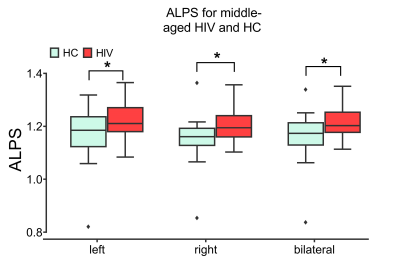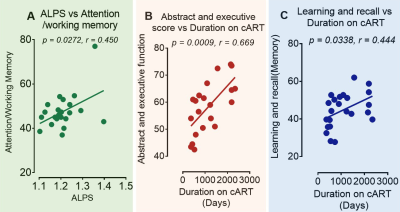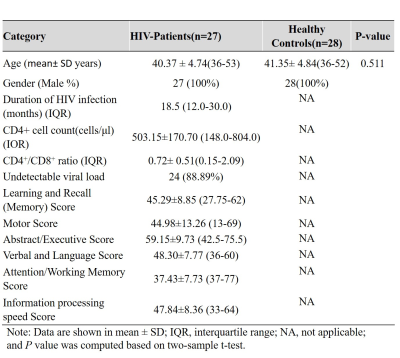2055
Assessment of Perivascular Glymphatic System Activity in Middle-aged HIV Infected Patients on Combination Antiretroviral Therapies1Hefei National Lab for Physical Sciences at the Microscale and the Centers for Biomedical Engineering, University of Science and Technology of China, Hefei, China, 2Department of Radiology, Beijing Youan Hospital, Capital Medical University, Beijing, China, 3School of Biological Science and Medical Engineering, Beihang University, Beijing, China
Synopsis
The brain activity underlying cognitive processing can be affected by HIV. We examine the ALPS index, a measure reflecting glymphatic system activity, along the perivascular space and its relationship with cognitive performance in middle-aged HIV infected patients successfully adhering to antiretroviral therapy. We found that the ALPS index was increased significantly in middle-aged HIV-infected patients receiving cART and was correlated with attention and working memory. The duration on cART was also associated with some cognitive measures. These findings suggest that ALPS index might provide an impetus for understanding cognitively relevant diffusivity changes following HIV or long-term use of cART.
Introduction
HIV infection is associated with neuroinflammation that plays a key role in the pathogenesis of several neurological disorders such as cognitive impairment1. These inflammations can be reduced through combination antiretroviral therapy (cART)2. We hypothesize that one possible mechanism through which inflammation is reduced might be by glymphatic system3 4, possibly allowing diffusion of HIV inflammation fluids, neurotoxins, amyloid- 𝛽, tau, and other brain metabolites5, thereby improves cognitive functions. The system depends on fluid transportation through the perivascular space and interstitial space6. Recently, studies7 have shown that glymphatic system evaluation can be achieved by Diffusion Tensor Imaging (DTI), allowing evaluation of water diffusivity along the x-direction of the periventricular white matter. Here, using DTI analysis along perivascular space (ALPS) index, we assessed the glymphatic system activity in middle-aged HIV-infected patients successfully adhering to cART, in association with cognitive performance and cART.Methods
Twenty seven middle-aged HIV patients on cART (tenofovir (TDF) + lamivudine (3TC) + efavirenz (EFV) (mean± SD age = 40.37 ± 4.74 years, range = 36 – 55 years) and 28 age-matched healthy controls (41.35± 4.84 years, range = 36 – 55 years) were recruited at Beijing YouAn Hospital from March 2016 to November 2016 for imaging and clinical neuropsychological assessments (Table 1). Siemens 3T MRI Scanner (TRIO TIM, Siemens Medical System, Erlangen, Germany) equipped with a 32-channel head coil was used to acquire images. Imaging protocols include a T1-weighted anatomical image (TR/TE=1900 ms/2.52 ms, inversion time = 900 ms, flip angle = 9°, field of view (FVO)=250 × 250 mm2, matrix size = 246×256, slice thickness = 1 mm, and voxel size =1 ×0.977 ×0.977 mm3) and a Diffusion-weighted imaging(DWI) sequence (60 diffusion-encoded (b=1000 s/mm2 ), 3 reference (b=0 s/mm2 ), TR=3300ms, TE=90 ms, flip angle = 90°, slice thickness= 4.2 mm, voxel size=2×2×4.2 mm3 ). DWI data were preprocessed using FSL (https://fsl.fmrib.ox.ac.uk/) and diffusivity maps were computed5. High-resolution T1w images were coregistered to the JHU ICBM template, and the same transformations were applied to the corresponding diffusivity maps. As it matches the direction of the deep white matter vessels, the water diffusivity along the x-axis is partly considered to reflect glymphatic system7. Using projection and association fibers (Figure 1) in the periventricular white matter from JHU ICBM-DTI-81 white matter atlas, passing along the wall of the lateral ventricles perpendicular to the x-axis, we computed the diffusivity along the x- and y-directions for the projection fibers (Dxpro, Dypro), and along the x- and z-directions for association fibers (Dxasc, Dzasc). The ALPS index5 7 was then estimated as follow: $$ALPS index=mean (Dxpro, Dxasc)/mean (Dypro, Dzasc)$$ The two-sample t-test evaluated group differences, and Pearson correlation tested for the relationship between ALPS index and clinical variables.Results
Our results showed a significant increase in the right, left, and bilateral ALPS indexes respectively in middle-aged HIV patients compared to healthy controls (Table 2, Figure 2). An increase in ALPS indexes along the right periventricular white matter was significantly correlated (p = 0.0272, r =0.450, Figure 3A) with attention and working memory in HIV patients at stable cART regimen. In these middle-aged HIV patients, a significant positive correlation was observed between duration on cART and cognitive performance scores of abstract and executive function (p = 0.0009, r =0.669, Figure 3B) and Learning and recall (p = 0.0009, r =0.669, Figure 3C)Discussion
We found that the ALPS index within the periventricular white matter was increased in middle-aged HIV patients receiving cART. The ALPS index was also correlated with some cognitive functions of these patients whose duration on cART was also associated with cognitive functioning. These findings suggest that uncontrolled viral proteins, inflammation, and other infectious activity of glial cells might threaten glymphatic system activity in HIV patients; however, the long-term use of cART, in conjunction with brain compensatory mechanisms, may synergistically enhance glymphatic system activity over time by reducing inflammation8 and increasing activity for the clearance of HIV-associated neurotoxins. This increase in glymphatic system activity may also be a potential for improving or restoring homeostasis associated with cognitive functioning of the brain. Further investigation is needed as most of the available antiretroviral therapies are thought to be less effective in reversing or improving HAND-related neurological dysfunction9, and disrupt microglial phagocytosis of β-amyloid in vitro studies10.Conclusion
The study suggests that ALPS index may be valuable in monitoring changes of glymphatic system activity in perivascular space. cART may be potential for enhancing glymphatic system activity over time, thereby improving or maintaining microenvironmental homeostasis for cognitive functions following HIV-neurotoxins. Further research is needed to understand the cellular mechanisms underlying activity changes in glymphatic system and the association with cognitive functions in middle-aged adults.Acknowledgements
We are grateful to all subjects who participated in this study.References
1. Gawron N, Choiński M, Szymańska-Kotwica B, et al. Effects of age, HIV, and HIV-associated clinical factors on neuropsychological functioning and brain regional volume in HIV+ patients on effective treatment. J Neurovirol 2019;25(1):9-21.
2. de Paula HHS, Ferreira ACG, Caetano DG, et al. Reduction of inflammation and T cell activation after 6 months of cART initiation during acute, but not in early chronic HIV-1 infection. Retrovirology 2018;15(1):1-11.
3. Harrison IF, Siow B, Akilo AB, et al. Non-invasive imaging of CSF-mediated brain clearance pathways via assessment of perivascular fluid movement with diffusion tensor MRI. Elife 2018;7:e34028.
4. Voldsbekk I, Maximov II, Zak N, et al. Evidence for wakefulness-related changes to extracellular space in human brain white matter from diffusion-weighted MRI. NeuroImage 2020:116682.
5. Yokota H, Vijayasarathi A, Cekic M, et al. Diagnostic performance of glymphatic system evaluation using diffusion tensor imaging in idiopathic normal pressure hydrocephalus and mimickers. Current Gerontology and Geriatrics Research 2019;2019
6. Mestre H, Kostrikov S, Mehta RI, et al. Perivascular spaces, glymphatic dysfunction, and small vessel disease. Clinical science 2017;131(17):2257-74. 7. Taoka T, Masutani Y, Kawai H, et al. Evaluation of glymphatic system activity with the diffusion MR technique: diffusion tensor image analysis along the perivascular space (DTI-ALPS) in Alzheimer’s disease cases. Japanese journal of radiology 2017;35(4):172-78.
8. Ellis R, Langford D, Masliah E. HIV and antiretroviral therapy in the brain: neuronal injury and repair. Nature Reviews Neuroscience 2007;8(1):33-44.
9. Saylor D, Dickens AM, Sacktor N, et al. HIV-associated neurocognitive disorder—pathogenesis and prospects for treatment. Nat Rev Neurol 2016;12(4):234-48.
10.
Giunta B, Ehrhart J, Obregon DF, et al. Antiretroviral medications disrupt
microglial phagocytosis of β-amyloid and increase its production by neurons:
implications for HIV-associated neurocognitive disorders. Mol Brain 2011;4(1):1-6.
Figures




Table 1. Demographic and clinical assessment data of HIV patients and healthy controls.

Table 2. HIV vs HC group analysis results for ALPS indexes.